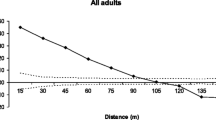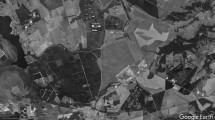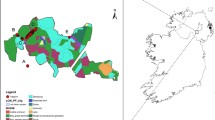Abstract
Anthropogenic impacts contribute to the fragmentation of urban mangrove forests, and in the Sydney region of Australia, Avicennia marina is commonly found in small stands of <50 adult trees that have altered pollinator services. However, genetic diversity may not vary with stand size because insufficient time has passed since stands were established or pollen and propagule dispersal are sufficient to overwhelm the effects of genetic drift and founder events. We tested the predictions that, despite the potential of mangroves for dispersal of propagules by water and long distance dispersal of pollen by honeybees, fragmentation and localized foraging by honeybees causes small stands of A. marina to display reduced genetic diversity and elevated inbreeding. Using four microsatellite markers, we quantified the genetic and genotypic diversity present within samples of 20 adults taken from three large (>1500 trees), intermediate (300–500 trees) and small (<50 trees) stands within each of two urbanized estuaries and estimated mating system parameters using progeny arrays for sets of five adults within the large and small stands. We detected no significant effect of stand size on levels of single-locus genetic diversity. There were low, although significant, levels of allelic differentiation within (F SE = 0.021, P = 0.003) and among (F ET = 0.055, P = 0.005) estuaries but no evidence of isolation by distance. In contrast, our analysis of progeny arrays revealed that, while all stands displayed high levels of biparental inbreeding, an expected consequence of pollination by honeybees, current outcrossing rates (t m ) were significantly lower in small (0.55) as compared to large (0.75) stands. The genetic makeup of the adult populations imply that stands are interconnected and suggest little impact of habitat fragmentation, while the progeny arrays suggest that plants within small stands may display reduced fitness.



Similar content being viewed by others
References
Aguilar, R., L. Ashworth, L. Galetto, and M.A. Aizen. 2006. Plant reproductive susceptibility to habitat fragmentation: review and synthesis through a meta-analysis. Ecology Letters 9: 968–980.
Aizen, M.A., L. Ashworth, and G. Leonardo. 2002. Reproductive success in fragmented habitats: do compatibility systems and pollination specialization matter? Journal of Vegetation Science 13: 885–892.
Arnaud-Haond, S., S. Teixeira, S. Massa, C. Billot, P. Seanger, G. Coupland, C.M. Duarte, and E.A. Serrão. 2006. Genetic structure and mating system at range-edge: low diversity and high inbreeding in Southeast Asian mangrove (Avicennia marina) populations. Molecular Ecology 15: 3515–3525.
Barrett, S.C.H., and J.R. Kohn. 1991. Genetic and evolutionary consequences of small population size in plants. In Genetics and conservation in rear plants, ed. D.A. Falk and K.E. Holsinger, 3–30. New York: Oxford University Press.
Clarke, P.J. 1993. Dispersal of gray mangrove (Avicennia marina) propagules in southeastern Australia. Aquatic Botany 45: 195–204.
Clarke, P.J., and P.J. Myerscough. 1991. Floral biology and reproductive phenology of Avicennia marina in South-eastern Australia. Australian Journal of Botany 39: 283–293.
Collinge, S.K. 2009. Ecology of fragmented landscapes. Baltimore: Johns Hopkins University Press.
Doyle, J., and J.L. Doyle. 1987. Genomic plant DNA preparation from fresh tissue—CTAB method. Phytochemical Bulletin 19: 11.
Duke, N.C. 2006. Australia’s mangroves. The authoritative guide to Australia’s mangrove plants. Brisbane: University of Queensland.
Duke, N., J.A.H. Benzie, J.A. Goodall, and E.R. Ballment. 1998. Genetic structure and evolution of species in the mangrove genus Avicennia (Avicenniaceae) in the Indo-West Pacific. Evolution 52: 1612–1626.
Dunstan, D.J. 1990. Some early environmental problems and guidelines in New South Wales estuaries. Wetlands (Australia) 9: 1–6.
England, P.R., F. Beynon, D.J. Ayre, and R.J. Whelan. 2001. A molecular genetic assessment of mating-system variation in a naturally bird-pollinated shrub: contributions from birds and introduced honeybees. Conservation Biology 15: 1645–1655.
Ghazoul, J. 2005. Pollen and seed dispersal among dispersed plants. Biological Reviews 80: 413–443.
Giang, L.H., P.N. Hong, M.S. Tuan, and K. Harada. 2003. Genetic variation of Avicennia marina (Forsk.) Vierh. (Avicenniaceae) in Vietnam revealed by microsatellite and AFLP markers. Genes and Genetic Systems 78: 399–407.
Goudet, J. 2001. FSTAT version 2.9.3, a program to estimate and test gene diversities and fixation indices. http://www2.unil.ch/popgen/softwares/fstat.htm.
Hamrick, J.L., and A. Schnabel. 1985. Understanding the genetic structure of plant populations: some old problems and a new approach. In Population genetics in forestry. Lecture notes in biomathematics 60, ed. H.R. Gregorious, 50–70. Berlin: Springer.
Hermansen, T.D., D.R. Britton, T.E. Minchinton, and D.J. Ayre. 2014a. Identifying the real pollinators? Exotic honeybees are the dominant flower visitors and only effective pollinators of Avicennia marina in Australian temperate mangroves. Estuaries and Coasts 37: 621–635.
Hermansen, T.D., D.J. Ayre, and T.E. Minchinton. 2014b. Effects of stand size on pollination in temperate populations of the mangrove Avicennia marina. Plant Ecology 215: 1153–1162.
Homer, L. 2009. Population structure and distance of gene flow in Avicennia marina (Forsk.) Vierh. (Avicenniaceae) on a local/regional scale in the Northern Rivers of New South Wales, Australia. PhD Thesis, Southern Cross University, Australia.
Jensen, J.L., A.J. Jeffrey, and S.T. Kelley. 2005. Isolation by distance, web service. BMC Genetics 6: 13.
Kahrood, H.V., S.A.A. Korori, M. Pirseyedi, A. Shirvany, and A. Danehkar. 2008. Genetic variation of mangrove species Avicennia marina in Iran revealed by microsatellite markers. African Journal of Biotechnology 7: 3017–3021.
Llorens, T.M., D.J. Ayre, and R.J. Whelan. 2004. Evidence for ancient genetic subdivision among recently fragmented populations of the endangered shrub Grevillea caleyi (Proteaceae). Heredety 92: 519–526.
Lomov, B., D.A. Keith, and D.F. Hochuli. 2010. Pollination and plant reproductive success in restored urban landscapes dominated by a pervasive exotic pollinator. Landscape and Urban Planning 96: 232–239.
Maguire, T.L., P. Saenger, P. Baverstock, and R. Henry. 2000a. Microsatellite analysis of genetic structure in the mangrove species Avicennia marina (Forsk.) Vierh. (Avicenniaceae). Molecular Ecology 9: 1853–1862.
Maguire, T.L., K.J. Edwards, P. Saenger, and R. Henry. 2000b. Characterisation and analysis of microsatellite loci in a mangrove species, Avicennia marina, (forsk.) Vierh. (Avicenniaceae). Theoretical and Applied Genetics 101: 279–285.
McLoughlin, L.C. 2000. Estuarine wetlands distribution along the Parramatta River, Sydney, 1788–1940: implications for planning and conservation. Cunninghamia 6: 579–610.
Melville, F., and M. Burchett. 2002. Genetic variation in Avicennia marina in three estuaries of Sydney (Australia) and implications for rehabilitation and management. Marine Pollution Bulletin 44: 469–479.
Melville, F., M. Burchett, and A. Pulkownik. 2004. Genetic variation among age-classes of the mangrove Avicennia marina in clean and contaminated sediments. Marine Pollution Bulletin 49: 695–703.
Miller, M.P. 1997. Tools for population genetic analysis (TFPGA) version 1.3. http://www.marksgeneticsoftware.net/tfpga.htm.
Minchinton, T.E. 2006. Consequences of pre-dispersal damage by insects for the dispersal and recruitment of mangroves. Oecologia 148: 70–80.
Pahl, M., H. Zhu, J. Tautz, and S. Chang. 2011. Large scale homing in honeybees. PLOS One e19669. doi:10.1371/journal.pone.0019669.
Pasquet, R.S., A. Peltier, M.B. Hufford, E. Oudin, J. Saulnier, L. Paul, J.T. Knudsen, H.R. Herren, and P. Gepts. 2008. Long-distance pollen flow assessment through evaluation of pollinator foraging range suggests transgene escape distances. PNAS 105: 13456–13461.
Paton, D.C. 1993. Honey-bees in the Australian environment. Does Apis mellifera disrupt or benefit the native biota? BioScience 43: 95–103.
Peakall, R., and P.E. Smouse. 2006. GENALEX 6: genetic analysis in excel. Population genetic software for teaching and research. Molecular Ecology Notes 6: 288–295.
Reed, D.H., and R. Frankham. 2003. Correlation between fitness and genetic diversity. Conservation Biology 17: 230–237.
Ritland, K. 2002. Extensions of models for the estimation of mating systems using n independent loci. Heredity 88: 221–228.
Ritland, K., and S.K. Jain. 1981. A model for the estimation of outcrossing rate and gene frequencies using n independent loci. Heredity 47: 35–52.
Roberts, D.G., K.M. Ottewell, R.J. Whelan, and D.J. Ayre. 2014. Is the post-disturbance composition of a plant population determined by selection for outcrossed seedlings or by the composition of the seedbank? Heredity 112: 409–414.
Rossetto, M., R. Jones, and J. Hunter. 2004. Genetic effects of rainforest fragmentation in an early successional tree (Elaeocarpus grandis). Heredity 93: 610–618.
Slatkin, M. 1993. Isolation by distance in equilibrium and non-equilibrium populations. Evolution 47: 264–279.
Southwick, E.E., and S.L. Buchmann. 1995. Effects of horizon landmarks on homing success in honey bees. American Naturalist 146: 748–764.
Thorogood, C.A. 1985. Changes in the distribution of mangroves in the Port Jackson–Parramatta River estuary from 1930 to 1985. Wetlands (Australia) 5: 91–96.
van Oosterhout, C., W.F. Hutchinson, P.M.D. Wills, and P. Shipley. 2004. MICRO-CHECKER: software for identifying and correcting genotyping errors in microsatellite data. Molecular Ecology Notes 4: 535–538.
Weir, B.S., and C.C. Cockerham. 1984. Estimating F-statistics for the analysis of population structure. Evolution 38: 1358–1370.
West, R.J., C.A. Thorgorod, T.R. Walford, and R.J. Williams. 1985. An estuarine inventory for New South Wales Australia. NSW: Fisheries Bulletin 2, Department of Agriculture.
Whelan, R.J., D.J. Ayre, and F.M. Beynon. 2009. The birds and the bees: pollinator behavior and variation in the mating system of the rare shrub Grevillea macleayana. Annals of Botany 103: 1395–1401.
Williams, D.A., Y. Wang, M. Borchetta, and M.S. Gaines. 2007. Genetic diversity and spatial structure of a keystone species in fragmented pine rockland habitat. Biological Conservation 138: 256–268.
Acknowledgments
This study was supported by a University of Wollongong postgraduate scholarship to TDH, by an ARC Discovery Grant to DJA and TEM and by the University of Wollongong’s Institute for Conservation Biology and Environmental Management.
Author information
Authors and Affiliations
Corresponding author
Additional information
Communicated by John C. Callaway
Appendix
Appendix
Rights and permissions
About this article
Cite this article
Hermansen, T.D., Roberts, D.G., Toben, M. et al. Small Urban Stands of the Mangrove Avicennia marina are Genetically Diverse but Experience Elevated Inbreeding. Estuaries and Coasts 38, 1898–1907 (2015). https://doi.org/10.1007/s12237-015-9955-1
Received:
Revised:
Accepted:
Published:
Issue Date:
DOI: https://doi.org/10.1007/s12237-015-9955-1




